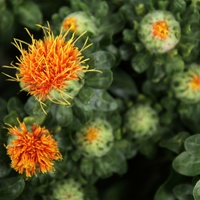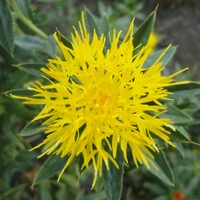Common name: Safflower
Other common names: American saffron, Bastard saffron, Dyers saffron, False saffron
Description
Safflower is a flowering oil- and dye-producing herb originating from Western Asia, its natural range extending across low-rainfall areas in Afghanistan, Pakistan and Western India.
An ancient crop, it has long been cultivated for its flowers and seed, the flowers for a natural dye and food colouring, and the seed for their oil, which has a wide range of uses. In India, it is cultivated mainly in the states of Karnataka and Maharashtra, particularly in the vicinities of Dharwad, Koppal, Nagpur, Phaltan and Solapur.
The plant itself is a much-branched annual herb 0.6 to 1.5 m (2 to 5 ft) tall with slim, round stems angled upward. There are many varieties and these can be divided into two main types, those with spiny leaves and those with leaves that are slightly spiny or spineless. The root system is extensive, and a deep, thick taproot develops, giving the plant good resistance to drought.
The leaves are elongated-oval, 10 to 15 cm (4 to 6 in) long, deep green and, depending on the variety, with spines on the margins and on the top, or are spineless. They are arranged spirally and alternately along the stems.
The flowers are small, tubular, yellow or orange-red and perfect, having both female and male parts. They are borne closely clustered in showy, rounded flower-heads at the ends of the branches and are followed by a small oily seed, either white or grey depending on the variety, protected in an angular hull.
Use
The seed yield a pale yellow, edible oil high in essential unsaturated fatty acids, including omega-3 fatty acids. It is widely produced as a cooking-oil or oil to make margarine and mayonnaise. The pressed seed-caked leftover after oil extraction is mixed in feed preparations for livestock, poultry and some species of pond-reared fish and shrimp.
Safflower oil is also a drying oil, which means it dries on exposure to air when applied in thin layers, making it a suitable oil for producing paints and varnishes, as well as soft soaps, skin softening lotions and hair conditioners. It has also been successfully engine-tested as a Biodiesel and is far along in its development, in Australia, as a substitute for petroleum-based oils, used as engine oil, hydraulic oil, electrical transformer oil and lubricating grease.
The whole, dehulled seed contain up to 35% oil and 17% protein and are roasted and eaten like a nut. They are also sold commercially as birdseed, for feeding pet birds.
The dried flowers are a source of natural red and yellow pigments used as a food colouring and for dyeing textiles. They can also be substituted for saffron in rice dishes such as Paella, and are added to rations fed to egg-laying hens to increase the yellow hue and intensity of the yolks.
The red pigment, know as 'Carthamine', colours natural cosmetic, particularly rouge, and is referred to as 'Rouge Végétal' or 'Rouge de Carthame' in France.
The flower-heads are harvested frequently, at least every third day over the flowering period, before the flowers have started to wither and before the seed has formed. They are then dried under shade before being packaged or processed to extract their red and yellow pigments.
Yields of dried flowers reported for plantations in India range from 50 to 75 kg per hectare or 45 to 67 lbs per acre.
The flowering stems are used in floral arrangements and are cut when the flowers are starting to open and showing some colour, as closed buds will not open after being cut from the plant.
Most of the lower leaves are stripped from the stem and a floral preservative is added to the vase water, which is changed every one to two days. They have a long vase-life, lasting from one to two weeks.
Non-spiny varieties are preferred for floral arrangements and for pigment production, whereas spiny varieties give the best seed yield.
Health use
The seed oil is rich in vitamin E and is reported to have cholesterol-lowering properties. Extracts of the flowers are prescribed in Traditional Chinese Medicine as a general blood tonic to improve blood circulation and for applying to wounds to stop pain and swelling and hasten healing.
Climate
Grows naturally in sub-humid warm-temperate, subtropical and tropical climates, generally areas with annual lows of 8 to 21°C, annual highs of 21 to 35°C and annual rainfall of 400 to 1200 mm.
Growing
New plants are started from seed, which are sown toward the end of the rainy season so that the seed have sufficient moisture to germinate and grow, leading into the dry season when the risk of fungal attack and disease are at their lowest.
Performs best on deep, rich, free-draining loam soils of a slightly acid to alkaline nature, generally with a pH of 6.0 to 8.0, and on sites with full to partial sun exposure.
Problem features
The seed are small and easily dispersed. It is listed as a weed in at least one reference publication and is recorded as a weed of agriculture and an invasive species in one or more countries. It is assessed as a high weed risk species for Hawaii, by the Hawaii Pacific Weed Risk Assessment (HPWRA) project.
Where it grows
References
Books
-
Ash, M. & Ash, I. 2004, Handbook of green chemicals, 2nd ed., Synapse Information Resources, Endicott, New York
-
Brady, G. S. & Clauser, H. R & Vaccari, J. A. 2002, Materials handbook : an encyclopedia for managers, technical professionals, purchasing and production managers, technicians and supervisors, 15th ed., McGraw-Hill, New York
-
Dastur, J. F. 1964, Useful plants of India and Pakistan : a popular handbook of trees and plants of industrial, economic, and commercial utility, 2nd ed., D. B. Taraporevala Sons, Bombay
-
Dean, J. 2010, Wild Color : the complete guide to making and using natural dyes (Revised and updated edition), Watson-Guptill Publishing, New York
-
Duke, J. A. 1983, Handbook of energy crops (unpublished), Center for New Crops & Plants Products, Purdue University, West Lafayette, Indiana
-
Food and Agriculture Organization of the United Nations (FAO) 1988, Traditional food plants : a resource book for promoting the exploitation and consumption of food plants in arid, semi-arid and sub-humid lands of eastern Africa, Food and Nutrition Paper No. 42, Rome
-
Gohl, B. 1981, Tropical Feeds : feed information summaries and nutritive values (Revised edition), Food and Agriculture Organization of the United Nations (FAO), Rome
-
Green, C. L. 1995, Natural colourants and dyestuffs : a review of production, markets and development potential, Food and Agriculture Organization of the United Nations (FAO), Rome
-
Gunstone, F. D. 2011, Vegetable oils in food technology : composition, properties and uses, 2nd ed, Wiley-Blackwell, Hoboken, New Jersey
-
Hunter, N. T & Mitchell, H. 1994, The art of floral design, Delmar Publishers, Albany, New York
-
Jamieson, G. S. 1943, Vegetable fats and oils : their chemistry, production, and utilization for edible, medicinal and technical purposes, 2d ed, Reinhold, New York
-
Jones, R. 2001, Caring for cut flowers, 2nd ed, Landlinks Press, Victoria, Australia
-
Khan, I. A. & Abourashed, E. A. 2010, Leung's encyclopedia of common natural ingredients : used in food, drugs and cosmetics, 3rd edition, Wiley Publishing, Hoboken, New Jersey
-
Litzenberger, S. C. 1974, Guide for field crops in the tropics and the subtropics, Office of Agriculture, Technical Assistance Bureau, Agency for International Development (USAID), Washington D.C.
-
Macmillan, H. F. 1943, Tropical planting and gardening : with special reference to Ceylon, 5th ed, Macmillan Publishing, London
-
McIlroy, R.J. 1963, An introduction to tropical cash crops, Ibadan University Press, Ibadan, Nigeria
-
McNab, J. M & Boorman, K. N 2002, Poultry feedstuffs supply, composition and nutritive value, CABI Publishing, Wallingford, United Kingdom
-
Randall, R. P. 2002, A global compendium of weeds, R.G. and F.J. Richardson Press, Melbourne
-
Randall, R. P. 2007, The introduced flora of Australia and its weed status, Cooperative Research Centre for Australian Weed Management, Glen Osmond, South Australia
-
Schafer, Peg & Foster, Steven, 1957- & Fannin, Sean 2011, The Chinese medicinal herb farm : a cultivator's guide to small-scale organic herb production, Chelsea Green Pub, White River Junction, Vt
-
Seidemann, J. 2005, World spice plants: economic usage botany taxonomy, Springer-Verlag, Berlin
-
Tacon, A. G. & Hasan, M. R. 2009, Feed ingredients and fertilizers for farmed aquatic animals : sources and composition, Food and Agriculture Organization of the United Nations (FAO), Rome
-
Winter, R. 2009, A consumer's dictionary of cosmetic ingredients : complete information about the harmful and desirable ingredients found in cosmetics and cosmeceuticals, 7th ed, Three Rivers Press, New York
Articles, Journals, Reports and Working Papers
-
Dagar, J. C. & Singh, G. 2007, Biodiversity of Saline and Waterlogged Environments: Documentation, Utilization and Management, NBA Scientific Bulletin, (9), 78.



